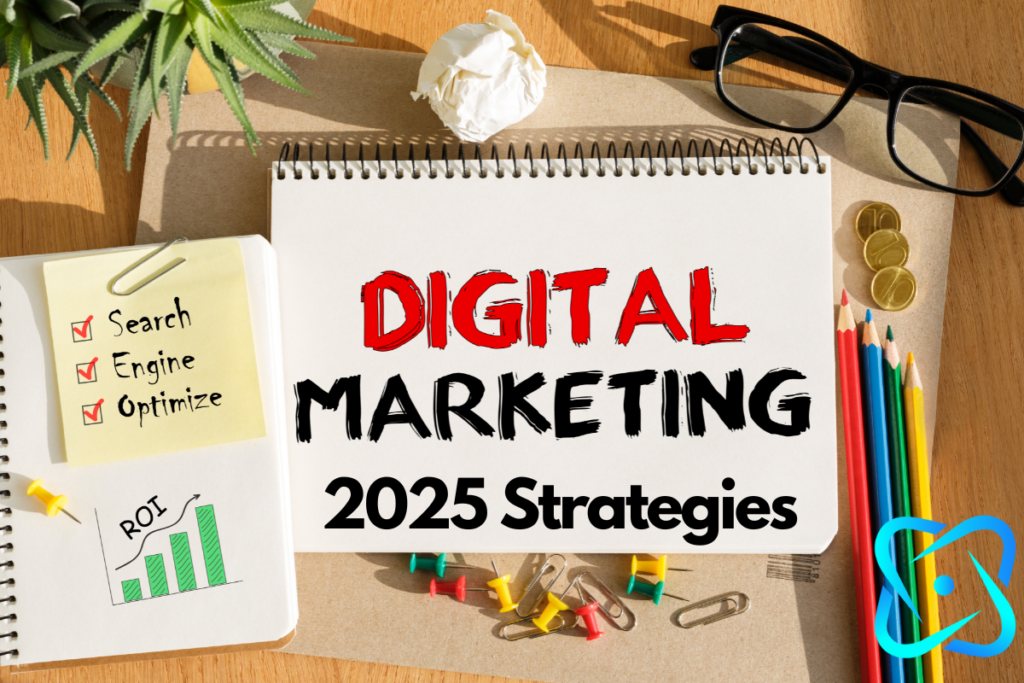Top 10 Digital Marketing Strategies for 2025
What I Wish I Knew When I Started Digital Marketing
When I first started my journey in digital marketing over a year ago, I felt completely lost. I didn’t have a clear direction, and every strategy I tried seemed to lead to frustration. There was so much conflicting advice out there that it was hard to know which path to follow. I’d spend hours implementing one approach, only to find it wasn’t yielding the results I hoped for.
There were days when I wondered if I’d ever figure it out. The digital marketing world seemed overwhelming and constantly changing, leaving me feeling like I was always one step behind.
But over time, I began to notice patterns. Through trial and error—and plenty of mistakes—I discovered that there were basic principles that consistently worked. These strategies gave me clarity and allowed me to build momentum. They weren’t quick fixes, but they laid the foundation for progress and sustainable growth.
From Lessons Learned to Future Success: Top Strategies for 2025
As we step into 2025, the digital marketing landscape continues to evolve at a rapid pace. With new technologies, platforms, and consumer behaviors shaping the industry, businesses must adapt to stay ahead of the competition. In this blog post, we’ll explore the top 10 digital marketing strategies for 2025 that can help your business thrive in this dynamic environment.
1. Embrace Artificial Intelligence and Machine Learning

In the ever-evolving world of digital marketing, staying ahead of the curve is crucial. One of the most groundbreaking advancements shaping this landscape is Artificial Intelligence (AI). Far beyond a mere buzzword, AI is fundamentally transforming how businesses strategize and execute their marketing efforts. Let’s dive into how AI is paving the way for smarter, more efficient marketing practices.
Understanding AI’s Role in Digital Marketing
Artificial intelligence, along with its close cousin machine learning, is rapidly changing the game for marketers. By analyzing vast amounts of data at lightning speed, AI can uncover deep insights into consumer behavior, predict upcoming trends, and tailor content to individual preferences. This level of personalization was once thought impossible, but AI makes it a reality.
According to a report by Statista, the global AI market is set to soar to an impressive $126 billion by the end of 2025. This explosive growth underscores the importance of integrating AI as part of your marketing strategies sooner rather than later.
How AI Enhances Marketing Strategies
So, how can businesses effectively harness the power of AI to boost their digital marketing efforts? Here are a few practical applications:
1. AI-Powered Customer Segmentation
One of the most effective uses of AI in marketing is through sophisticated customer segmentation. AI can sift through mountains of data to group customers based on their behavior, preferences, and demographics. This allows marketers to craft highly targeted campaigns that resonate with specific audience segments, thereby increasing engagement and conversion rates.
2. Chatbots for Customer Service
Gone are the days when customer service was confined to traditional call centers. AI-powered chatbots are revolutionizing the way businesses interact with their customers. These chatbots provide instant responses to customer queries, offer product recommendations, and even handle complaints—all while learning from each interaction to improve over time. This not only enhances customer satisfaction but also frees up human resources for more complex tasks.
3. Personalized Email Campaigns
Email marketing remains a powerful tool in the digital marketer’s arsenal. With AI, businesses can take personalization to the next level. By analyzing user behavior and preferences, AI can help craft email content that is not only relevant but also tailored to individual recipients. This increases the likelihood of emails being opened, read, and acted upon, ultimately driving higher conversion rates.
2. Optimize for Voice Search
In today’s fast-paced digital landscape, staying ahead of the curve means embracing new technologies and trends. One such trend that’s rapidly gaining traction is voice search optimization.
With the proliferation of voice-activated devices like Amazon Alexa, Google Assistant, and Apple’s Siri, it’s clear that voice search is not just a passing fad—it’s here to stay.
By 2025, it’s anticipated that a staggering 50% of all online searches will be voice-based. So, what does this mean for it to be part of your digital marketing strategies? Let’s dive into why optimizing for voice search should be on your radar and how you can get started.
Understanding Voice Search Optimization
Voice searches differ from traditional text searches in several key ways. They tend to be longer, more conversational, and often phrased as questions. For instance, instead of typing “best Italian restaurants NYC,” a user might ask, “What are the best Italian restaurants in New York City?” This shift towards natural language queries means that your content needs to adapt accordingly.
Why Voice Search Matters
With more people using voice-activated devices daily, optimizing for voice search is becoming increasingly crucial. Here are a few reasons why voice search matters:
- Convenience: Voice search offers a hands-free, faster way for users to find information, making it an attractive option for multitaskers.
- Increasing Adoption: With smart speakers and virtual assistants becoming household staples, the number of voice searches is only set to grow.
- Competitive Edge: Businesses that optimize early can capture this growing audience and gain a competitive advantage.
How to Optimize for Voice Search
Here are some practical steps to ensure your content is voice-search friendly:
Provide Direct Answers: Aim to answer specific questions directly within your content. This increases the likelihood that your site will be featured in a voice search response.
Focus on Natural Language: Use a conversational tone in your content. Think about how people speak and tailor your content to match that style.
Incorporate Question-Based Keywords: Since voice searches often start with questions like “who,” “what,” “where,” “when,” “why,” and “how,” integrating these question phrases into your content can improve your chances of appearing in voice search results.
Enhance Local SEO: Many voice searches are local in nature, such as “find a coffee shop near me.” Ensure your business information is up-to-date on Google My Business and other local directories.
Optimize for Mobile: Voice search often happens on mobile devices, so it’s crucial to have a mobile-friendly website. Ensure your site loads quickly and is easy to navigate on smaller screens.
3. Focus on Personalization
Another personal focus as part of your marketing strategies toolbox is personalization.
Consumers today expect personalized experiences tailored to their preferences and needs. Personalization can significantly impact customer satisfaction and loyalty.
A study by Evergage found that 98% of marketers believe personalization advances customer relationships. Utilize data analytics to understand customer behavior and deliver personalized recommendations, emails, and content.For instance, Netflix uses data analytics to track viewing habits and preferences, allowing it to offer personalized show and movie recommendations that enhance user engagement and satisfaction.
4. Leverage Video Marketing

Video content remains a powerful tool in digital marketing strategies. With platforms like YouTube, TikTok, and Instagram Reels gaining popularity, video marketing offers a unique way to engage with your audience.
Research from Wyzowl indicates that 86% of businesses use video as a marketing tool, and 93% of marketers say video has helped increase user understanding of their product or service. And according to a report by HubSpot, 54% of consumers want to see more video content from brands or businesses they support.
This underscores the importance of integrating video into your marketing strategy to effectively engage and educate your audience. Consider creating short, engaging videos that showcase your brand’s personality and values.
5. Invest in Influencer Marketing
Influencer marketing continues to be a powerful strategy for reaching new audiences. By collaborating with influencers who align with your brand, you can tap into their established follower base and build credibility.
According to Business Insider, the influencer marketing industry is set to reach $15 billion by 2025. Choose influencers who resonate with your target audience and create authentic, engaging content that reflects your brand’s values.
6. Utilize Interactive Content
Interactive content, such as quizzes, polls, and interactive infographics, can boost engagement and increase time spent on your website. This type of content encourages users to actively participate and share their experiences.
A report from Content Marketing Institute found that 81% of marketers believe interactive content grabs attention more effectively than static content. Consider incorporating interactive elements into your marketing strategies to capture and retain your audience’s interest.
7. Prioritize Social Media Engagement

Social media platforms are constantly evolving, and businesses must adapt their marketing strategies to keep up. In 2025, prioritize engagement over mere presence by actively interacting with your audience and responding to comments and messages promptly.
Statistics from Hootsuite show that 73% of marketers believe social media marketing has been very effective for their business. Utilize features like Instagram Stories, LinkedIn polls, and Twitter threads to encourage interaction and build a loyal community.
8. Implement Data-Driven Decision Making
Data-driven decision-making is crucial for optimizing digital marketing strategies. By analyzing data from various channels, businesses can make informed decisions and refine their marketing efforts.
A survey by Deloitte found that 49% of high-performing marketers use data to drive decisions. Implement tools like Google Analytics and CRM systems to track performance metrics and gain valuable insights into customer behavior.
9. Commit to Sustainability and Social Responsibility
Consumers are increasingly conscious of the environmental and social impact of their purchases. Brands that commit to sustainability and social responsibility can build trust and loyalty with their audience.
A study by Nielsen revealed that 81% of global respondents feel strongly that companies should help improve the environment. Highlight your brand’s sustainability initiatives and ethical practices in your marketing campaigns to resonate with conscious consumers.
10. Enhance User Experience with Augmented Reality

Augmented reality (AR) is revolutionizing the way consumers interact with products online. By providing immersive experiences, AR can enhance user engagement and drive conversions.
According to Threekit, 61% of consumers prefer retailers that offer AR experiences. Consider integrating AR into your marketing strategy through virtual try-ons, interactive product demos, and 360-degree views.
Conclusion
As we look towards 2025, embracing these top 10 digital marketing strategies can help your business thrive in the ever-evolving digital landscape. From leveraging AI and video marketing to prioritizing personalization and sustainability, these marketing strategies offer opportunities for growth and innovation. Stay ahead of the curve by continuously adapting and optimizing your digital marketing strategies to meet the changing needs of your audience.



